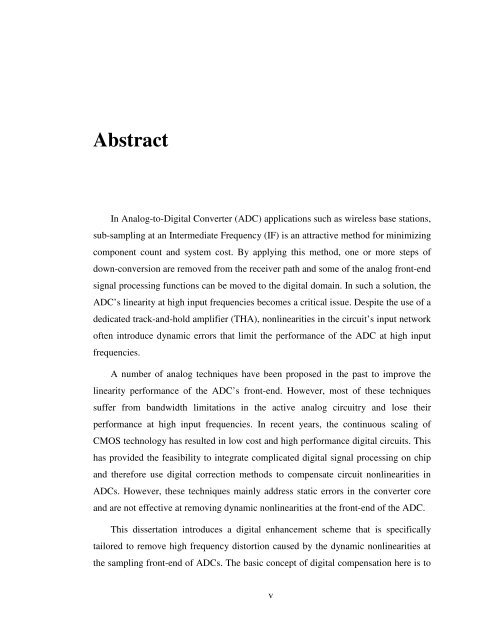digital compensation of dynamic acquisition errors at the front-end of ...
digital compensation of dynamic acquisition errors at the front-end of ...
digital compensation of dynamic acquisition errors at the front-end of ...
Create successful ePaper yourself
Turn your PDF publications into a flip-book with our unique Google optimized e-Paper software.
Abstract<br />
In Analog-to-Digital Converter (ADC) applic<strong>at</strong>ions such as wireless base st<strong>at</strong>ions,<br />
sub-sampling <strong>at</strong> an Intermedi<strong>at</strong>e Frequency (IF) is an <strong>at</strong>tractive method for minimizing<br />
component count and system cost. By applying this method, one or more steps <strong>of</strong><br />
down-conversion are removed from <strong>the</strong> receiver p<strong>at</strong>h and some <strong>of</strong> <strong>the</strong> analog <strong>front</strong>-<strong>end</strong><br />
signal processing functions can be moved to <strong>the</strong> <strong>digital</strong> domain. In such a solution, <strong>the</strong><br />
ADC’s linearity <strong>at</strong> high input frequencies becomes a critical issue. Despite <strong>the</strong> use <strong>of</strong> a<br />
dedic<strong>at</strong>ed track-and-hold amplifier (THA), nonlinearities in <strong>the</strong> circuit’s input network<br />
<strong>of</strong>ten introduce <strong>dynamic</strong> <strong>errors</strong> th<strong>at</strong> limit <strong>the</strong> performance <strong>of</strong> <strong>the</strong> ADC <strong>at</strong> high input<br />
frequencies.<br />
A number <strong>of</strong> analog techniques have been proposed in <strong>the</strong> past to improve <strong>the</strong><br />
linearity performance <strong>of</strong> <strong>the</strong> ADC’s <strong>front</strong>-<strong>end</strong>. However, most <strong>of</strong> <strong>the</strong>se techniques<br />
suffer from bandwidth limit<strong>at</strong>ions in <strong>the</strong> active analog circuitry and lose <strong>the</strong>ir<br />
performance <strong>at</strong> high input frequencies. In recent years, <strong>the</strong> continuous scaling <strong>of</strong><br />
CMOS technology has resulted in low cost and high performance <strong>digital</strong> circuits. This<br />
has provided <strong>the</strong> feasibility to integr<strong>at</strong>e complic<strong>at</strong>ed <strong>digital</strong> signal processing on chip<br />
and <strong>the</strong>refore use <strong>digital</strong> correction methods to compens<strong>at</strong>e circuit nonlinearities in<br />
ADCs. However, <strong>the</strong>se techniques mainly address st<strong>at</strong>ic <strong>errors</strong> in <strong>the</strong> converter core<br />
and are not effective <strong>at</strong> removing <strong>dynamic</strong> nonlinearities <strong>at</strong> <strong>the</strong> <strong>front</strong>-<strong>end</strong> <strong>of</strong> <strong>the</strong> ADC.<br />
This dissert<strong>at</strong>ion introduces a <strong>digital</strong> enhancement scheme th<strong>at</strong> is specifically<br />
tailored to remove high frequency distortion caused by <strong>the</strong> <strong>dynamic</strong> nonlinearities <strong>at</strong><br />
<strong>the</strong> sampling <strong>front</strong>-<strong>end</strong> <strong>of</strong> ADCs. The basic concept <strong>of</strong> <strong>digital</strong> <strong>compens<strong>at</strong>ion</strong> here is to<br />
v
















